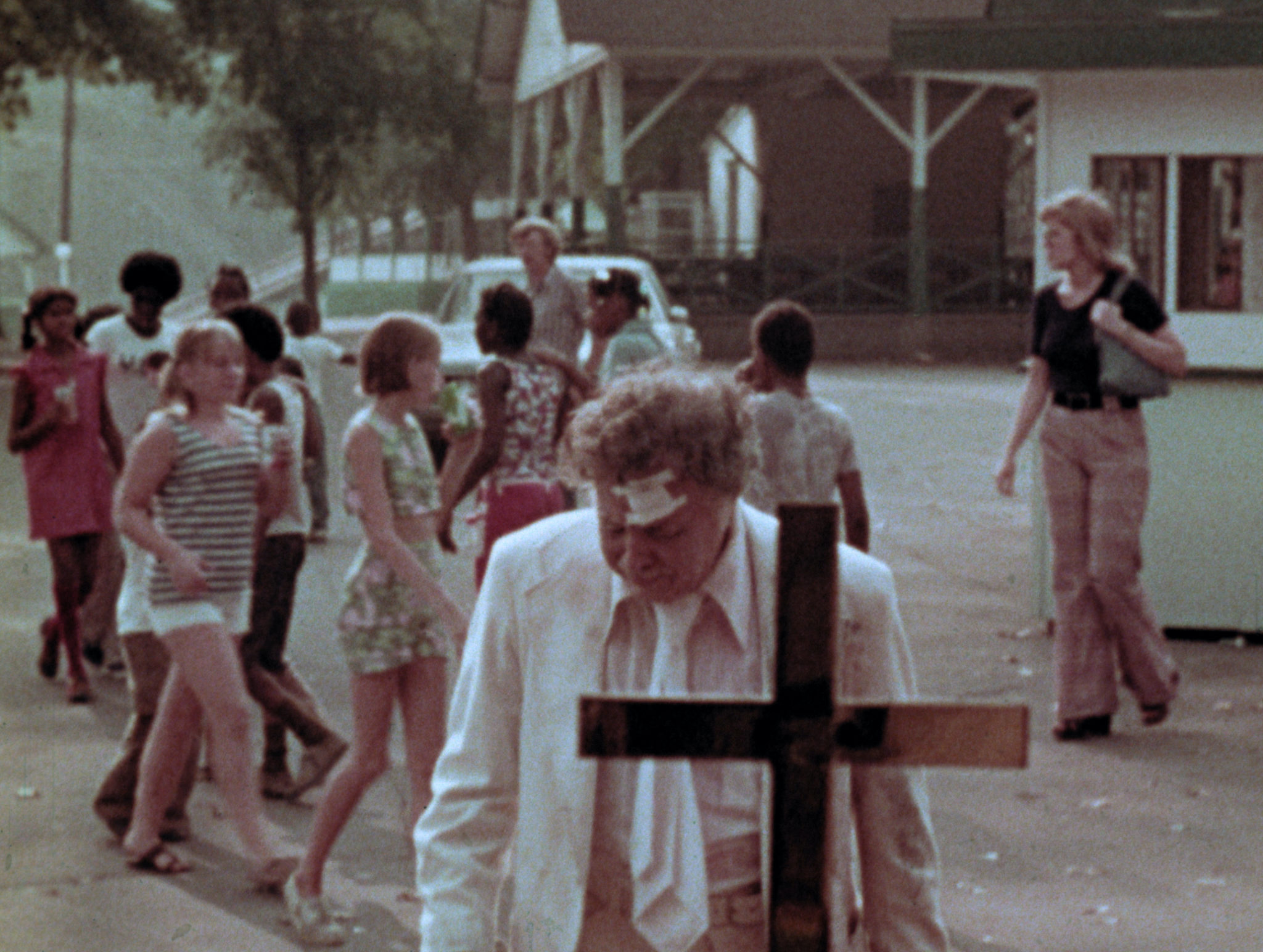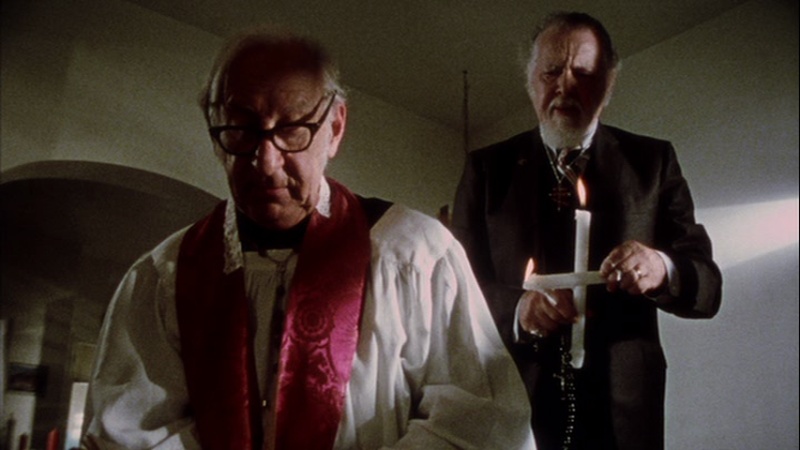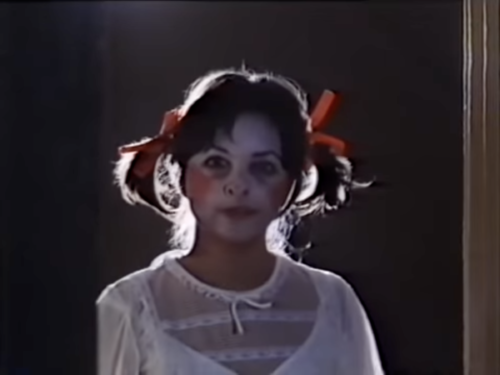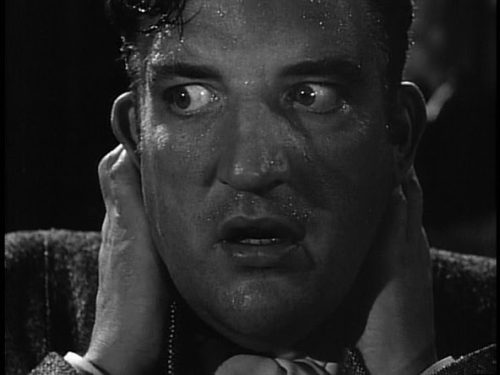Romero’s long-lost industrial film communicates the horror of living in a body and living in America at least as well as many of his lauded features
Throughout The Long Gray Line (1955), maybe the best film about the indifference of history and the inevitability of time’s steady progress, director John Ford repeatedly uses a military parade to represent both. Despite five decades and two World Wars, the titular column of West Point cadets marches on. Come whatever, they play the same songs, the same way, on the same days of every year. For Martin Maher (Tyrone Power) and his wife Mary (Maureen O’Hara) — whose lives are distinguished by an overabundance of death and disappointment — that routine constitutes life’s one dependable source of comfort. It’s the parade, right on schedule as always, that consoles Mary after the death of a newborn, in her own final moments, and through all the tear-marked years in between.
The film’s unusual framing device — one it might share with Yankee Doodle Dandy (1942) alone — finds an elderly Martin recounting his decades at West Point to President and former cadet Dwight D. Eisenhower (Harry Carey Jr.). After more than 50 years in the Hudson Valley, serving in roles ranging from waiter to gym instructor to surrogate father, Martin is finally facing forced retirement. He’s taken the trip to Washington out of desperation; he’s even going AWOL to make it happen.The word ageism wouldn’t exist for another decade-plus, but Martin initially positions his plea as an argument against age-based discrimination. He’ll acknowledge that he’s grown nearsighted and gained “a pound or two” with age. He still won’t go into retirement quietly. It’s only after two hours and decades worth of flashback that the true nature of Martin’s feelings becomes clear. He doesn’t just feel as if he’s being unfairly forced out of life in the Army. The real issue is that he can’t imagine a life divorced from the Army and its dependable routines. “Everything I treasure in my heart, living or dead,” he says, “is at West Point. I wouldn’t know where else to go.”
West Point finally repays his affection and years of service in the film’s breathtaking final sequence. Fearing retribution, Martin returns home to a surprise parade in his honor. A crowd is assembled and the cadets have adapted their usual tunes to suit his tastes. “An utter mediocrity” like Martin can’t hope to transcend life’s endless march, or even walk in step with it, but he can take comfort in the knowledge that, at least this once, it marched with him in mind.
A parade also marches through the most impressive and upsetting sequence of George A. Romero’s long-shelved The Amusement Park (1975). Its effect is quite the opposite of those parades that reassure Mary and lacks the emotional payoff of the one that marches Martin into retirement and death. Rather than providing reassurance to the viewer or the characters on screen, it simply and cruelly reiterates the modern world’s distance (ever increasing) from the people it decides to leave behind.

The Amusement Park was conceived with a similar mission as Martin Maher’s fictive trip to see the President. In 1973, at the behest of the Lutheran Service Society of Western Pennsylvania, Romero was tasked with exposing the horrific treatment afforded America’s senior citizens and calling the audience to action. The film’s belated premiere both validates its initial rejection (what could those Lutherans possibly have thought of the final product?) and solidifies Romero’s place among horror’s great high-minded auteurs. Even at this early stage, Romero possessed a unique talent for communicating the horrific indignities of life under capitalism for the unlucky masses. Throughout The Amusement Park’s brief yet harrowing runtime, life’s forces (never unseen, but almost always unspoken) make a victim of an avuncular, unnamed senior played by Lincoln Maazel.
Maazel introduces the film and its intentions by introducing himself to the viewer in a pair of explanatory bookend sequences. Nearing 71, he’s employed as an actor and all too familiar with what an unusual treat employment and its benefits are for a man of his years. He remarks that the “basic fulfillment” afforded by living, staying active, and contributing to society are, unfortunately, a rare privilege for the aged. Monologuing like a less-subtle Rod Sterling, he characterizes the wisdom and ability of older populations as a neglected “natural resource” and calls this neglect nothing less than a “national tragedy.” At first, today’s audiences may raise an eyebrow at the assertion that ageism represents the most insidious form of discrimination; I certainly did. Then comes Maazel’s sly warning. Though his schoolmasterly countenance remains unchanged, he becomes less Rod Serling than the Cryptkeeper when he says to the audience, “Remember, as you watch the film, one day you will be old.” The horrors that follow could one day look familiar to each and every one of us. We’re all queueing up for our place at the amusement park.
While The Amusement Park doesn’t feature the walking dead who’d help Romero make his name, it announces its position in an undead world from the very start. Maazel, immaculately dressed in a white suit, walks into a sterile, white room to meet a distressed doppelganger, almost unrecognizable as his double. “Do you ever go outside?” the new Maazel asks. “There’s nothing outside,” the bleeding, sweating clone assures him through wheezing breaths, “you won’t like it.” Still, our elderly surrogate elects to see for himself what waits behind the door. He’s immediately overwhelmed by a bustling crowd, observed by unseeing faces and bypassed by uncaring feet.
Related: Appropriately Vague: George A. Romero’s The Crazies (1973) by Brett Wright
Romero doesn’t avoid the screamingly obvious analogues between an amusement park and the disorientation and distress of old age. It’s hard to imagine a better vessel for delivering his message than a rollercoaster, which goes up and down, turns stomachs, and inspires terror, only to return to its starting point, ready to do the same all over again. No one would ever call The Amusement Park subtle. A deliberately cluttered soundscape mixes carnival barking with the mechanical sounds of rides, laughs, chatter, and ticking clocks. The crowd surrounds Maazel on either side, often overwhelming him and the frame. These audio and visual tricks are employed throughout and their effect is both cyclical and cumulative. If the film is repetitive — it’d be hard to argue that it’s not — that’s all the better. After all, we’re not watching a solitary experience in the life of a single old man, but the day-to-day ordeals of a kind of every-senior. Maazel faces shocking treatment, to be sure. It’s no shock or surprise at all, however, when, at the end of the film, he walks back through a white door into the same white room where he started. If all these things were bound to happen, it’s only natural they’d happen again and again and again.

Before Maazel boards the park’s one roller coaster, he’s faced with a series of signs, more evidence of the true nature of Romero’s critique. Where a typical amusement park might check riders’ heights, this one checks their income and asks whether or not they fear the unknown. Before entering the park, seniors queue up to trade their valuables for tickets. Later on, a vision test will prove necessary for getting behind the wheel of a bumper car and a police officer will intervene after a collision. Does this all amount to Bansky-level observation and commentary? Sure. But, Romero’s uncommon skill as a director, editor, and social commentator all become clear when Maazel peeks through a fortune teller’s tent to see the grim fate of a young couple. While he’s positioned like a child peeking in at a carnival peep show, the sights behind the tent flaps are anything but titillating.
“We want to know if we’re still gonna be together,” the young man asks. The crystal ball reveals the unfortunate end point of his partner’s devotion. Decades from now, he’ll die in a squalid Pittsburgh apartment while his wife pleads to their doctor on a payphone and would-be Samaritans march past. “Dr. Jones, my husband is so bad,” she implores. This isn’t enough to earn pity, let alone attention. The doctor is occupied with patients who’ve got tickets to spend. At this point, Maazel has seen enough; he walks away from the tent and takes a seat on a nearby bench, newly contemptuous (or at least contemplative) of his own contemporaries. Though he’s no longer there to watch it, the bleak vision continues. “As poor as we are, we’ve always paid our bills” the old woman pleads. It’s not enough to save her husband. She shouts, “God help you if you have to have this on your conscience,” but the sounds of drums begin to drown her out. A parade marches past and dominates the soundtrack. “Why are people so mean? Why can’t anybody help me?” Being a good patient can’t attract the doctor’s concern and it certainly can’t stall the progress of the parade. The young man leaves the tent and assaults Maazel on the way out, who suddenly finds himself totally alone in the park.

After being beaten by bikers, dismissed by healthcare providers, and harassed by the audience at an ageist “freak show,” Maazel finally finds a place to rest. He takes a seat beside a group of children to watch as a parade goes by. Predictably, the parents arrive and soon it’s just a handful of seniors watching the drummers fade into the distance. Maazel walks off again. Happening upon a child picnicking with her mother, he attempts to play a role that ought to come naturally, that of a kindly, grandfatherly elder. He begins to read the story of “The Three Little Pigs.” It’s a parable that predates him and will outlive him, perhaps the ideal tool for bridging a generational gap and fostering a sense of togetherness. The girl’s mother ushers her without even seeming to notice him. It’s somehow the cruelest ostracization yet, a suggestion that his presence doesn’t even register and that he’s ceased to matter at all. After a bout of sobs, he ends up back where he started, waiting to greet another unsuspecting clone.
Lincoln Maazel lived to 106, but made just one on-screen appearance during his lifetime. In Romero’s masterpiece, Martin (1978), he plays Cuda, who grudgingly welcomes his cursed younger cousin (John Amplas) into his Braddock, Pennsylvania, home. Amplas’ title character may or may not be a vampire. Black-and-white sequences continually transport us from the Rust Belt to a gothic fantasy realm. Here, Martin’s not just a blood-drinking home invader, but a genuine vampire. Still, it’s often clear that he knows the difference. Despite his crimes and constant fixation on blood, he consistently reminds his elderly guardian that “there isn’t any magic,” suggesting perhaps that the fantasies are products of Cuda’s delusions rather than his own. That’s certainly Christina (Christine Forrest)’s contention. “Look in the book,” he begs her, asking her to abandon the secular skepticism of the young and acknowledge the family curse. Romero’s attitude toward older generations evidently curdled between 1973 and 1978 while the divide between young and old continued to widen.
Cuda’s both a champion for family tradition and the depressed town of Braddock itself, fiercely protective of it and its residents. As the owner of a grocery store, he’s a patriarch of sorts as well as a friend to his elderly clientele. He rails against the young people who leave for better opportunities and threatens Martin with damnation if he feasts on anyone within the city limits. When Christina lights out with her boyfriend, it’s an affront twice over. She’s rejecting two different ways of life. Martin, for his part, briefly stakes an uneasy place of his own in Braddock. Most of Cuda’s patrons dismiss him as lazy, but the lonely, alcoholic Mrs. Santini briefly strikes up an affair with him and replaces bloodlust with just plain lust. Her sudden suicide seems less shocking to Martin than it ought to. He calls into a local radio show, which has previously helped make him a local celebrity and object of fun, to explain his feelings. “You get used to things,” he remarks, “you get used to your life and it all gets easier.” His call coincides with a parade through Braddock. In spite of everything we’ve seen from the city and heard about its decline, the event is packed with young people. While Martin has previously lurked in the shadows and shrunk from attention, he now begins to walk alongside a marching band and reclaim his position in the procession of everyday life.
Martin’s newfound comfort proves short-lived. He wakes the next day to the sounds of church bells and the accusing eyes of Cuda, who evidently missed the parade and Martin’s seemingly innocent attempt to join it. Cuda drives a stake through Martin’s heart and buries him in the backyard while the closing credits roll. Taking a seat to admire his work and wipe his brow, he looks as alone as at any point during The Amusement Park. The drummers and trumpeters are long gone and Cuda is left to age alongside his city and his customers.
Stream The Amusement Park on Shudder
Stay up to date with all things Split Tooth Media and follow Bennett on Letterboxd
(Split Tooth may earn a commission from purchases made through affiliate links on our site.)





